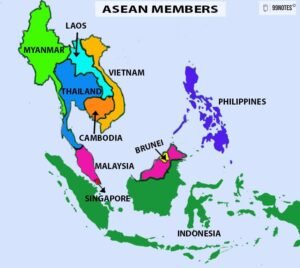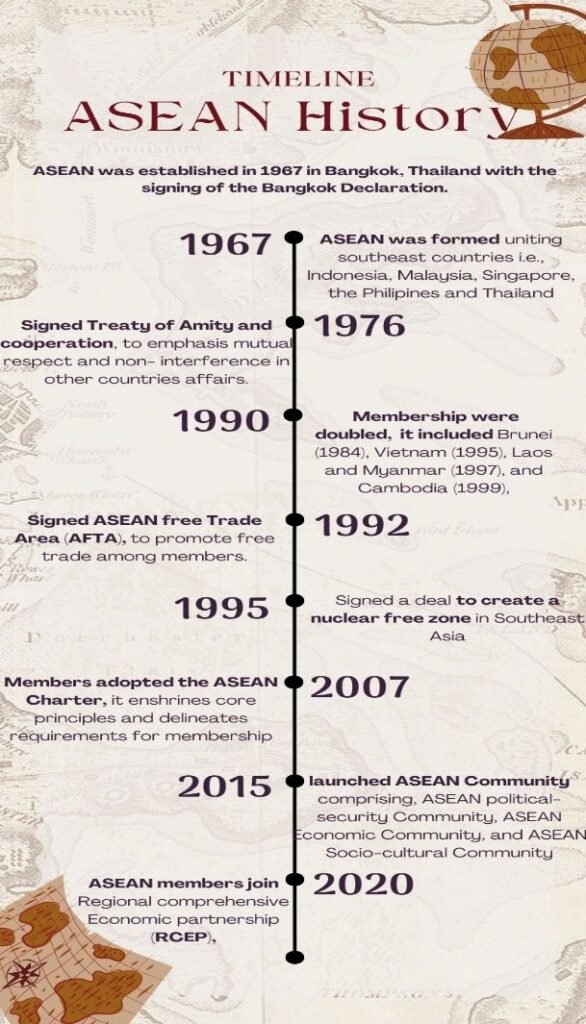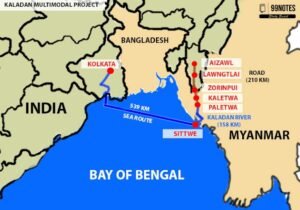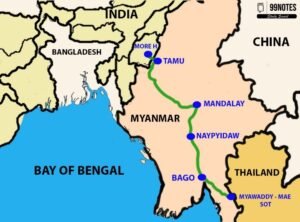ASEAN
The Association of Southeast Asian Nations (ASEAN) is a regional organization formed by the governments of Malaysia, Indonesia, Thailand, Philippines, and Singapore to promote economic growth, peace, social progress, security and cultural development in the Southeast Asian region.
ASEAN was established on 8th August 1967 in Bangkok, Thailand, with the signing of the Bangkok Declaration. In 2007, the ten Southeast Asian Countries, i.e., Brunei, Cambodia, Malaysia, Indonesia, Laos, Myanmar, Philippines, Singapore, Thailand and Vietnam, adopted the ASEAN Charter, a constitutional document that provided the grouping with legal status and an institutional framework.
History of ASEAN:
In 1967, ASEAN was formed with southeast countries, i.e., Indonesia, Malaysia, Singapore, the Philipines and Thailand. It sought to create a common united front against the spread of communism and promote economic, political and social stability in between rising tensions in Asia Pacific.
- In 1976, the members of ASEAN signed the Treaty of Amity and Cooperation in Southeast Asia, to give special importance to mutual respect and non-interference in other countries’ affairs.
- In the 1990s, membership in ASEAN doubled. The countries were Brunei (1984), Vietnam (1995), Laos and Myanmar (1997), and Cambodia (1999); the group launched an initiative to boost regionalism.
Evolution of ASEAN
The ASEAN was strengthened with the help of several agreements since the 1990s.
- In 1992, Member countries signed the ASEAN Free Trade Area (AFTA) to promote free trade among members.
- In 1995, the members signed a treaty to create a nuclear-free zone in Southeast Asia.
- In 2007, the members adopted the ASEAN Charter, it provides a legal framework and enshrines core principles and delineates requirements for membership.
- In 2015, the ASEAN Community, comprising the ASEAN Economic Community, ASEAN Political-security Community, and ASEAN Socio-cultural Community, was launched.
- In 2020, ASEAN members joined the Regional Comprehensive Economic Partnership (RCEP), which is a free trade agreement.
Such agreements, make ASEAN only the second organisation in the world to have an objective to achieve integration after the EU. However, there are marked differences between the two.
Comparison between the European Union and ASEAN:
ASEAN and EU are often referred to be more successful regional organisations. There are differences between them as follows:
| European Union | ASEAN |
| EU adopts an intrusive approach, imposing numerous conditionalities even in domestic matters. | ASEAN adheres to the non-interference principles known as the “ASEAN Way” emphasising respect for territorial integrity and sovereignty. |
| EU works in a supranational nature where nations have pooled their sovereignty. | ASEAN operates as an intergovernmental organisation. |
| The EU follows a single currency. | ASEAN adopts a Currency Swap arrangement. |
| The EU works and emphasises a more qualified majority. | ASEAN works on consensus. |
| EU has a parliament, which is a unique concept for any international organisation. | ASEAN does not have a Legislative body with members elected by a franchisee. |
India-ASEAN Relations:
India’s relationship with ASEAN is a crucial pillar of our foreign policy and the foundation of our Act East policy. The ASEAN bilateral relationship started evolving when India introduced the ‘Look East Policy’ in the 1990s.
| Look East to Act East Policy |
|
- India began formal engagement with ASEAN in 1992 as a “Sectoral Dialogue Partner”.
- In 1996, ASEAN became a full dialogue partner.
- In 2002, India’s status was elevated and it became a summit-level partner India was invited by ASEAN to become a part of all its initiatives like the ASEAN regional forum, East Asia Summit, ADMM+ and RCEP.
India-ASEAN Agreements
- In 2009, India signed a free trade agreement in goods with the ASEAN countries.
- In 2010, India entered into the ASEAN India Free Trade Area (AIFTA), which is India’s first and only regional trading agreement.
- In 2012, the partnership between the two elevated to a “Strategic Partnership”.
- In 2015, a separate Mission was also set up for ASEAN and the EAST Asia Summit in Jakarta with a dedicated Ambassador to strengthen engagement with ASEAN and ASEAN-centric processes.
- In 2015, India signed a free trade agreement in services with 10 ASEAN groupings.
- In 2018, the strategic partnership between India and ASEAN will be focused on building cooperation in the maritime domain.
- In 2022, the 19th ASEAN India summit commemorated the 30th anniversary of ASEAN India Dialogue relations, and on occasion, the partnership was elevated to the “Comprehensive Strategic Partnership”. The year is embarked as “ASEAN-India Friendship Year.”
| 19th India- ASEAN summit was held in Cambodia |
At the 19th ASEAN summit, several steps were taken to step up the engagement between India and the ASEAN.
|
Significance of India- ASEAN relations
- Geopolitical: ASEAN is central to India’s Act East Policy and Indo-Pacific Vision and contributes to the Security and Growth for All in the Region (SAGAR) initiative.
- Regional Integration and Multilateral Cooperation: India’s engagement with ASEAN is part of its broader commitment to regional integration and multilateralism. ASEAN serves as a platform for cooperation and dialogue on various regional and global issues.
- Economic Cooperation: India and ASEAN registered a bilateral trade of USD 131.5 billion in 2022-2023. The trade with ASEAN accounted for almost 11.3% of India’s global trade in 2022-23.
- Development of Northeast: Connectivity through the India-Myanmar-Thailand Trilateral Highway (IMT) and the Kaladan Multimodal Project, etc., have led to greater connectivity with the Northeast and ensured progress and development in the region.
- Security: Partnership between ASEAN and India helps in countering Terrorism, Violent Extremism and Transnational Crimes through the implementation of the ASEAN Plan of Action in Combating Transnational Crime (2016-2025)
- China Factor: Countering China has been a major driving factor behind India’s interactions with Southeast Asian countries. China releasing a new map and falsely claiming territories (land and maritime) of India and Southeast Asian countries would further add to the shared concerns between India and ASEAN.
- Soft Power: For India to become a civilizational superpower, apart from economic and military might, Southeast Asia is a natural destination to practice soft power.
- Southeast Asia shares cultural commonalities with India, including temples, yoga, epics like the Ramayana and Mahabharata, and the practice of Ayurveda.
Area of Convergence:
The ties between ASEAN and India have been on an upswing in the past few years, with the focus being on ramping up cooperation in the areas of investment and trade, security and defence, and others. Some of these are as follows:
Economic cooperation:
India and ASEAN are important economic partners. Together, they share 7% of the world’s GDP and 26 % of the world’s Population.
- Bilateral Trade: ASEAN is India’s fourth-largest trading partner.
The bilateral trade between the two was US$ 9 Billion in 2002, which increased to US$ 150 billion in 2023.
- Free Trade Agreement: Both sides have signed a free trade agreement known as the ASEAN-India Trade in Goods Agreement (AITGA) to boost trade between the two.
- Import and Export: India’s exports to ASEAN increased from $25.63 billion in 2010-2011 to 51 billion in 2022-2023, its imports also increased from USD 30.61 billion to USD 87.59 billion in the same period.
- Investment: Singapore emerged as the largest source of Foreign Direct Investment in India in 2023, with an investment of $17.20 billion. It has also been the second-largest source of cumulative FDI from 2000 to 2023. During this period, FDI from Singapore accounted for 23% of India’s total FDI.
- Local currency and UPI: to further strengthen trade and exchange, ASEAN member states such as Malaysia have started trade with India in Local currency. The member states have also shown their deep interest in Indis’s UPI. For instance, India and Singapore have started deeper collaboration in FinTech, including interoperability in payment systems.
- Increasing private sector engagement: ASEAN and India set up the ASEAN India Business Council as a forum to bring important private players from India and ASEAN on a single platform for sharing ideas and business networking.
Regional Connectivity:
Both sides are actively working on enhancing regional connectivity by establishing multi-modal connectivity and economic corridors that link Southeast Asia, India, and West Asia Europe through initiatives such as the India-Myanmar-Thailand (IMT) Trilateral Highway and the Kaladan multimodal Transit transport project.
Kaladan multimodal Transit transport project:
The Kaladan project is entirely funded by India. It was built to seek an alternative route through Myanmar for the transportation of goods to India’s northeast region. It connects Kolkata in India to Sittwe and Paletwa in Myanmar by sea and river, respectively.
It serves a strategic purpose by creating an alternative to the Siliguri corridor, relieving pressure on the existing route.
Mekong Ganga Initiative:
This has been India’s strategic initiative to weaken China’s initiative. It is an initiative by 6 countries, India and five ASEAN countries, i.e., Cambodia, Lao PDR, Myanmar, Thailand and Vietnam, which enable cooperation in tourism, culture, education, as well as transport and communication.
- It is an initiative to counter China’s similar initiative called the Greater Mekong Region.
- The project integrates four Mekong countries, i.e., Vietnam, Myanmar, Cambodia, and Thailand along with India, connecting Ho Chi Minh City, Dawei, Phnom Penh and Bangkok, with Chennai. The corridor will provide opportunities for the participant countries to develop infrastructure, enhance their economic base within the region, and reduce the transit distance between the two countries.
India-Myanmar-Thailand (IMT) Trilateral Highway:
This project connects three countries through a road from Moreh in India to Mae Sot in Thailand to Bagan in Myanmar. Further, it was extended to Cambodia and Vietnam.
Cooperation on Maritime Security:
The two sides agreed to further strengthen India-ASEAN cooperation on maritime safety and security, promote cooperation in a blue economy and develop new and renewable energy, including marine-based renewable energy, among others.
- India and ASEAN enhanced their maritime cooperation with the first ASEAN India Maritime Exercise (AME) in 2023. The two indigenously built guided missile destroyers, INS Delhi and INS Satpura, also participated. Along with the Indian navy, the navies of Brunei, Indonesia, Malaysia, the Philippines, Singapore, Thailand and Vietnam participated in the exercise.
- India and several ASEAN countries conducted the MILAN exercise.
- India also conducts bilateral coordinated patrols with several ASEAN countries.
- India strategically places ASEAN at the centre of its Indo-Pacific vision, which is known as security and growth for all in the region (SAGAR).
- The Maritime cooperation was one of the important focus areas of the ASEAN Outlook on the Indo-Pacific (AOIP).
People-to-people ties:
- Socio-cultural cooperation: the cultural connection between India and ASEAN members is deep and broad. Hinduism and Buddhism came to Southeast Asia from India. The Indian languages, such as Sanskrit and Pali, have influenced several of the region’s scripts. Great scripts such as Ramayan are also read and performed in ASEAN countries.
- India organizes a large number of programmes to boost people-to-people interaction with ASEAN. For instance, students are invited to India annually for the student exchange programme, special training courses for ASEAN diplomats, etc.
- Both sides organised Delhi Dialogue, which is India’s premier annual track 1.5 international conference, to discuss ways to identify areas of cooperation leading to further strengthening the ASEAN India Strategic Partnership.
- Tourism: The number of tourists from India to ASEAN increased to 238 million from 81,131 in 2021.
- ASEAN countries were invited to join the Global Centre for Traditional Medicine being established in India by WHO and also to work together on Mission LiFE, which is an India-led global mass movement to nudge individual and community action to preserve and protect the environment.
- ASEAN countries were also invited by India to join the coalition for Disaster Resilient Infrastructure and called for cooperation in disaster Management.
Areas of Concern:
- Great power competition: Southeast Asia is increasingly becoming a theatre of great power competition between the china and United States because of its location in the broader Indo-Pacific region.
- Widening trade deficit: There is a disproportionate trade balance favouring ASEAN due to non-tariff barriers, import regulations, etc. The trade deficit has widened to $43.57 billion in 2022-23 from USD 25.76 billion in 2021-22. It was just USD5 billion in 2010-11.
- Competing regional agreements: The engagement of ASEAN countries with other regional agreements like the RCEP (Regional Comprehensive Partnership) and the (CPTPP) Comprehensive and Progressive Agreement for Trans-Pacific Partnership diverts attention and resources away from the ASEAN-India relationship.
- Lack of market access and connectivity: Physical and digital connectivity between India and ASEAN countries remains limited, affecting trade, investment, Business-to-business and people-to-people ties.
- Delayed projects: Since the conception of project IMT trilateral highway in 2002, it has faced various delays and challenges, including political instability in Myanmar and financial issues. Now, it is expected to be completed by
- China Factor: India’s primary strategic focus in Southeast Asia is countering China’s influence. However, India has yet to offer a compelling alternative, allowing China to maintain its dominance in both the economic and strategic realms within Southeast Asia.
Concerns within ASEAN:
- Regional Imbalance in the economic and social status of its member countries.
- With rising income inequality Gap between rich and poor ASEAN member states remains quite large.
- GDP difference among member countries for instance, Singapore has the highest GDP of $53000 (2016) while Cambodia’s per capita GDP is the lowest at $1,300.
- Many regional initiatives were not able to be incorporated into national plans, as the less developed countries faced resource constraints to implement the regional commitments.
- Within the ASEAN region member countries face border disputes and conflicts, illegal migration, ethnic crises, terrorism, etc.
- The member countries don’t have a proper dispute settlement mechanism.
Way forward
- Prevention of Regional Hegemony is needed to maintain peace and stability. Rather than focusing on individual vision, a Common interest should be promoted. Collective dialogue and synergy are required for expanding cooperation between India and ASEAN.
- Strengthening Regional and Physical Connectivity: The strengthening sea, land, and air linkages and early completion of pending projects, for instance, the India-Myanmar-Thailand (IMT) Trilateral Highway, will help to advance people-to-people flow and also boost trade and investment.
- Synergies with sub-regional framework: the two sides should explore synergies with sub-regional frameworks such as the Indian Ocean Rim Association (IORA), BIMSTEC, etc., to promote equitable development by aligning sub-regional growth.
- Maritime security in the Indo-Pacific: Due to maritime disputes with China, ASEAN countries have limited military ties with China. By filling this gap, India can become a key military partner in the region.
- India intends to build a hundred smart cities, and ASEAN to create a network of smart cities. There is scope for leveraging their respective competitive sectoral advantage. One of the cooperations is already underway; for instance, Singapore’s Surbana Jurong is assisting with smart city development in Maharashtra.









